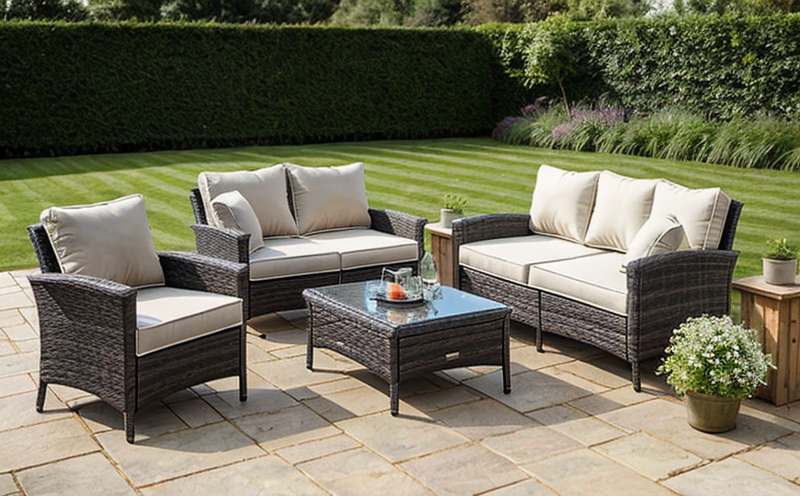ASTM D2240 Hardness of Plastic and Rubber Components in Outdoor Furniture Testing
The ASTM D2240 standard provides a standardized method for determining the hardness of plastic and rubber materials, which is crucial for ensuring durability and performance in outdoor furniture. This test evaluates how resilient these components are to deformation under pressure, a critical factor given the harsh environmental conditions they must endure outdoors.
The process involves pressing a specific indenter onto the surface of the material with a defined force, then measuring the depth of indentation. The hardness is calculated using the Shore hardness scale, which ranges from 0 to 100. For outdoor furniture components such as cushions, armrests, and seating areas made from plastic or rubber, this test ensures that they can withstand constant exposure to sunlight, rain, and temperature fluctuations without compromising their structural integrity.
Outdoor furniture often uses materials like polyethylene (PE), polypropylene (PP), and certain rubbers which require robust testing. The ASTM D2240 hardness test helps manufacturers understand how these materials will perform in real-world conditions. By conducting this test, they can optimize the material selection and design to enhance the longevity of their products.
The testing procedure is straightforward but precise. Specimens are cut into small pieces that fit into a specific holder designed for the ASTM D2240 hardness tester. The indenter is pressed down onto the sample with a specified force, and the depth of indentation is measured using a micrometer. This measurement is then used to calculate the Shore hardness value.
Understanding the hardness values helps manufacturers decide on appropriate materials that can withstand outdoor environments. For instance, higher hardness ratings may be required for armrests or seating areas where users will place their weight frequently. On the other hand, softer materials might be preferred for cushioning elements to provide comfort while maintaining durability.
Industry standards like ASTM D2240 ensure consistency across tests conducted by different laboratories around the world. This standardization is vital when comparing results from various sources or when conducting international studies and collaborations.
The importance of this test cannot be overstated, particularly for furniture manufacturers targeting outdoor markets. It provides a critical metric that influences design decisions and ultimately impacts customer satisfaction and product longevity. By adhering to these standards, companies can ensure their products meet regulatory requirements and exceed expectations in terms of quality and reliability.
Industry Applications
| Application Area | Description |
|---|---|
| Furniture Design and Development | This test is integral in the early stages of designing outdoor furniture, helping manufacturers choose materials that can withstand environmental stresses. |
| Quality Assurance and Control | ASTM D2240 ensures consistent quality by providing a standardized method for testing material hardness. |
| Regulatory Compliance | Making sure the materials used meet industry standards is essential for compliance with local regulations regarding outdoor furniture. |
- Furniture manufacturers use this test to select materials that can endure harsh outdoor conditions.
- It helps in ensuring a high level of product quality and reliability, which enhances customer satisfaction.
Competitive Advantage and Market Impact
- By adhering to ASTM D2240 standards, furniture manufacturers can differentiate their products through superior durability and performance.
- This standardization ensures that all tests are conducted in a consistent manner, leading to more reliable data for decision-making.
The use of ASTM D2240 hardness testing is particularly beneficial for companies operating globally. It allows them to maintain uniform quality standards across different regions, which can be critical for expanding into new markets or maintaining existing ones.
For quality managers and compliance officers, this test offers a robust framework to ensure that all products meet the required standards. This not only helps in avoiding potential legal issues but also enhances brand reputation by delivering high-quality products.
R&D engineers can use this testing method to innovate within their industry. By continuously evaluating materials based on ASTM D2240, they can discover new applications for existing materials or develop novel compounds that better suit the demanding outdoor environment.
Use Cases and Application Examples
In practice, this test is used extensively in various scenarios:
- Determining the appropriate cushion material for a garden chair to ensure it remains comfortable over time despite exposure to elements.
- Choosing the right armrest material that can withstand heavy use without deforming or breaking down quickly.
- Evaluating the durability of rubber components in outdoor tables and benches, ensuring they remain functional through seasonal changes.
For manufacturers aiming for long-term success in the outdoor furniture market, implementing ASTM D2240 hardness testing is essential. It allows them to make informed decisions that enhance product performance while maintaining compliance with international standards.





